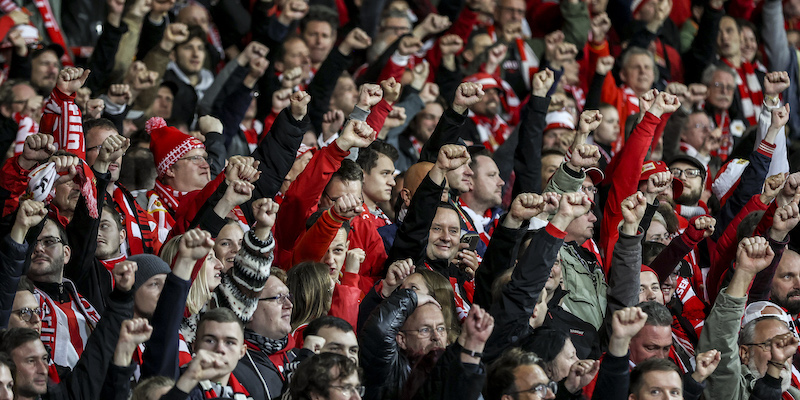After last weekend’s results there are three teams tied for the lead in the German football league, the Bundesliga. Two are obvious: Bayern Munich, who have won it for ten years in a row, and Borussia Dortmund, the best-equipped rival. The other one is big news from wherever you look at it, because Union Berlin, in addition to being a special team, has never been so high.
Just four years ago Union were playing in the second division and had never been in the Bundesliga. Since 2019, the year of his debut, he has done nothing but improve, going from eleventh place to fifth place last year, with qualification for the European cups attached. Since he’s been in the Bundesliga, he’s always been better than he should be based on numbers and budgets. In the past season they were the penultimate team in the league in terms of wages and overall squad value; this year she is the fourth last in terms of signings and the eleventh in terms of squad value.
The results are impressive and well above expectations, but when it comes to Union Berlin they are only part of the story.
The current club is the result more than a century of crossings and indeed union among dozens of small local teams whose center since 1920 has been the popular district of Köpenick, in old East Berlin. This center is represented in particular by the stadium close to a large public park, the An der Alten Försterei, which for three quarters is made up of bare steps, without seats, as was the custom in the past.
(Maja Hitij/Getty Images)
An der Alten Försterei was rebuilt in 2009 by voluntary fans, the same ones who saved the club from probable bankruptcy in 2004, also with the refunds that those who donate blood receive in Germany. The plant is also at the service of the community that built it: at Christmas, for example, it hosts a large Christmas market where over 20,000 people gather among stalls, traditional songs and charity events.
In Germany, professional football clubs cannot be owned by a single entity: the majority of their shares must be owned by the members, therefore fans and supporters. It is the so-called “50+1” rule, which is applied, with exceptions, by all the teams, creating great attachment and participation, as demonstrated by the always full stadiums and the beautiful atmosphere that reigns in general.
However, Union is special because it not only respects the majority position of popular shareholders, but applies this concept to all of its shares. All of its 48,368 members count equally and none can have more “weight” than the others, as happens instead in other clubs (Bayern Munich, for example, whose minority shareholders include large companies such as Adidas, Audi and Allianz ). The current president of the Union, Dirk Zingler, is just one fan among many, with experience in the business sector, elected by the majority of members. His decisions must always receive the approval of a group of supervisorsthat is, of other fans.
This corporate line has been inherited naturally from the history of the club. After the construction of the Berlin Wall and the division of the city between sectors, Union remained a team with a strong working-class connotation and ended up playing in the DDR championship, where heartfelt rivalries arose with the teams controlled by the military and police corps. above all Dynamo Berlin and Dynamo Dresden. The opposition to the two state teams made Union the reference football team for dissidents and later also for the thick punk and skinhead scenes in a city historically linked to subcultures. From there also the motto «Eisern Union» (the union of iron) was born, as the title of the hymn sung by Nina Hagen.

(Maja Hitij/Getty Images)
Even if at the end of the season it fails to win the championship, or to qualify for the Champions League for the first time, the club is already trying to capitalize on what it has achieved so far, also because it puts back into circulation and reinvests everything it earns in the club (only the last year closed the balance sheet with a surplus of 12.7 million euros with an increase in revenues of 50 percent from the previous year).
And so in 2024 he plans to redo the stadium, but not to replace the concrete bleachers, which will remain, nor to install an electronic scoreboard, because the manual one always works, but because the demand for tickets is so high that now it would fill twice the current 22,000-seat stadium.
Union has always had a complicated history and is now experiencing its best moment, which happens in the worst period for Hertha, the West Berlin team, historically the most relevant. Nicknamed “die alte Dame”, which as for Juventus in Italy means “the old lady” has an austere and important past, but between long-standing internal strife and wrong investments, she once again risks relegation.
In recent years, the derby between the two Berlin teams has become increasingly heated. In 2024, however, Union will temporarily move to Hertha’s stadium, the Olympiastadion, where they already play their European matches because the concrete bleachers at An der Alten Försterei do not comply with UEFA rules. In two years, however, Union could also be the only team from Berlin in the Bundesliga.
– Read also: The part of Berlin where football doesn’t work
